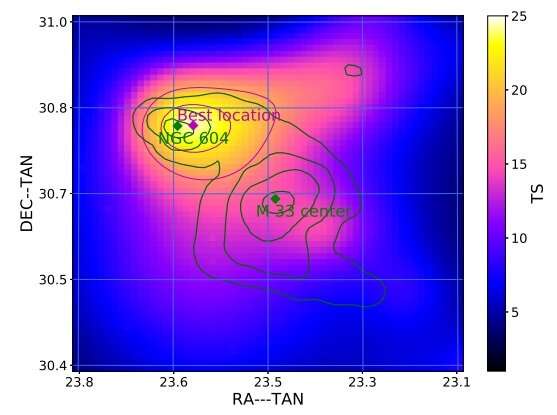March 24, 2020 report
Chinese astronomers detect gamma-ray emission from two star-forming galaxies

Astronomers from Nanjing University in China have detected gamma ray emission from two star-forming galaxies designated M33 and Arp 299. The finding, which is detailed in a paper published March 17 on arXiv.org, could be helpful in improving knowledge about the origin of very high-energy emission in galaxies.
It is believed that gamma rays in galaxies are the result of interaction of cosmic rays with the interstellar gas. Star-forming galaxies are huge reservoirs of cosmic rays and therefore could be crucial for studies of extragalactic gamma ray emission. However, the list of known star-forming galaxies detected in gamma rays is still relatively short, hence finding new ones and studying them in detail is of high importance for astronomers.
Now, a team of astronomers led by Shao-Qiang Xi reports the detection of two star-forming galaxies in gamma rays. The discovery was made as part of a systematic search for possible gamma ray emission from galaxies in the IRAS Revised Bright Galaxies Sample, using data from NASA's Fermi spacecraft.
"We selected our sample galaxies from the IRAS Revised Bright Galaxies Sample, excluding the 15 IR-bright galaxies that have been detected in gamma rays with Fermi–LAT and listed in Fermi–LAT Fourth Source Catalog. We performed the standard sequence of analysis steps for each galaxies, resulting in the detection of two new gamma ray sources that are, respectively, spatially coincident with M33 and Arp 299," the astronomers wrote in the paper.
M33, or Messier 33 (also known as the Triangulum Galaxy) is the third largest galaxy in the Local Group. It is located some 2.73 million light years from the Earth in the constellation Triangulum. The researchers measured a flux of approximately 1.28 perg/cm2/s in the energy range 0.1 − 100 GeV. This value indicates a luminosity of about 1.1 duodecillion erg/s.
Located around 130 million light years away in the constellation Ursa Major, Arp 299 is one of the most powerful star-forming galaxies in the local universe. It is a pair of colliding galaxies in an advanced merging state, NGC 3690 to the west and IC 694 to the east, plus a small compact galaxy to the northwest. In the energy range 0.1 − 100 GeV, the flux was measured to be about 1.08 perg/cm2/s.
What is interesting in the case of Arp 299 is that the study found evidence of flux variability in gamma ray emission from this galaxy. The astronomers explained that it may be partly due to the contribution from the obscured active galactic nuclei (AGN) in Arp 299.
"If the variability is true, part of the emission should originate from the obscured AGN in this interacting galaxy system," the paper reads.
Summing up the results, the researchers concluded that the fluxes of M33 and Arp 299 are consistent with the correlation between the gamma ray luminosity and the total infrared luminosity for star-forming galaxies. This supports the hypothesis that gamma ray emission from such sources is mainly due to cosmic rays interacting with the interstellar medium.
More information: Discovery of GeV gamma-ray emission from M33 and Arp 299 with Fermi-LAT, arXiv:2003.07830 [astro-ph.HE] arxiv.org/abs/2003.07830
© 2020 Science X Network





















